Calculadoras Calculator blog
Calculator blog
Musings and comments about our common interest
A method to calculate pi based on Pythagoras theorem
I have been reading recently a novel about Pythagoras: “Pythagoras killing”, from Marcos Chicot. It depicts a thriller in Pythagoras’ time, where some of the mathematical themes of that era were discussed.
At that time, Pi was not known among the greek. They knew that the relation between the circumference and its diameter was slightly greater than three, but they did not know how to calculate it - even less to understand that it was an irrational number. Moreover, the Pythagorean school thought that all magnitudes in nature came from exact ratios between integer numbers.
In the story, there is a rich man versed in maths that offers a huge amount of gold to whom is able to tell him the ratio between the diameter and the circumference with 4 decimals. The villain (that happens to be a former Pythagoras disciple) wins it with a method based (to add injury to Pithagoras) on the Pythagorean theorem. In principle, these were the only available means to mathematicians of that era to calculate PI - none of the modern methods were available.
A light clicked and I set to calculate PI as well as I could with my Prime. I started doing it with this small graph, and then checked it with a spreadsheet. It is based on calculated more and more sides of the circle, based on the previously calculated side. Good! with 25 iterations, it reaches the 15 decimals available in Excel - the iteration 26 shows 0 difference with Pi.
Will any of you be able to program it with the HP Prime? If you don’t feel comfortable with it, you can try with any other HP calculator, either in RPN or RPL
This Friday I will show the solution. You have 3 days to solve it!
HP Prime user keys
Some clever shortcuts for HP Prime
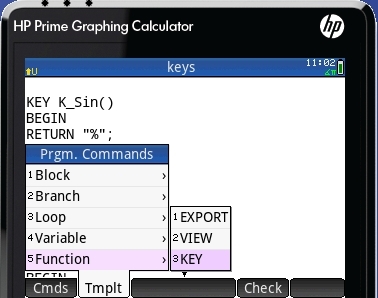 The user keyboard in the HP Prime gives us great flexibility in configuring our calculator. Those that had used the HP50g and HP41c were used to this feature (I can’t remember now if the keyboard was fully configurable with the HP42s. Other calculators only had function keys, that, while useful, is a completely different thing)
The user keyboard in the HP Prime gives us great flexibility in configuring our calculator. Those that had used the HP50g and HP41c were used to this feature (I can’t remember now if the keyboard was fully configurable with the HP42s. Other calculators only had function keys, that, while useful, is a completely different thing)
Unless you’re a student with very wide subjects to cover, you will have several tasks that you perform very often, and you’ll want to automate them as much as possible. I have my HP41cl fully customized to my liking - no wonder it is still my preferred calculator. While others serve me well, this is the one that has everything I want at my fingertips. Now it makes sense to do the same thing with the HP Prime
The key assignment procedure is covered in page 516, but the way it is described, it looks like you only can program it to return a text. In fact, if you try to make it do anything else, it will give you a syntax error.
You need to write short programs for each of your key assignments. Don’t worry: it is extremely simple and you have a template for it, that can be launched from the template soft key in the program screen.
I have created a program file called “Keys” where I store all the key definitions I use. Putting them in more places will only result in a mess when changing the configuration. Only creating the little program and activating the user keyboard (either for a single key or permanently) is enough to enable the assigned key (I need to check whether you can restrict the application of the key definitions, by locating its program within a specific app)
The syntax is very easy, and, as said before, it can be launched from a template, as seen on the picture beside. I use a lot of percentage comparisons, and, on the other hand, very few trigonometric functions, so I mapped all three typical percentage functions (already existing in the Prime) to the three trigonometric keys, on their main unshifted meaning:
KEY K_Sin()
BEGIN
RETURN “%”;
END;
KEY K_Cos()
BEGIN
RETURN “%CHANGE()”;
END;
KEY K_Tan()
BEGIN
RETURN “%TOTAL()”;
END;
What does it does? It writes at the cursor position the text between inverted commas. It does not separate it from the previous number, but we’ll see shortly after that it does not matter.
Note that if you want to reprogram shifted keys, you may do it as well, by changing the key prefix:
K_ stands for main key
KS_ is for shifted keys
KA_ is for alphanumeric
KSA_ is for shifted alphanumeric
The coding of each particular key is shown in page 518 of the manual. (The full manual can be shown in the Windows Prime emulator, in the help menu)
How does it work? The rest of the discussion assumes entry mode is RPN.
Imagine you want to calculate 25% of 235. You write 235, enter, 25, press the SIN key, it appends a “%” character to the 25, now press enter, and you have the result. Note that you did not have to separate the % from the number - but it didn’t look bad anyway.
Now try this: you want to see the % change between 235 and 200. You press 235, enter, 200, COS, and you see on the screen:
235
200%CHANGE()
Now that looks ugly. You can, of course, press enter after the 200, then press COS, then press enter again. But that’s one key pressed too much! Same for entering an space before COS
Just try like above. It works!
As it works like that, I would not enter a space in the program itself - who knows if it can wreak havoc in other situations!
Old HP calculators and programming quality
Old HP machines!
We’re now in the wake of the new major release of Mac operating system, Yosemite. There will be a number of new features but also correction for many small errors of the previous software. This is typical of today’s software: due to its own complexity, it is bug-ridden, and unsafe in many respects.
Compare that with the 12k * 10 bit of the assembly code of the HP15c. That code was crammed with fantastic mathematical routines that allowed that calculator to perform matrix operations, integrals and solve formulae. Most of the HP15c that have not been physically battered are still working. And talk about battery life. Around 8 pm I receive a 10% battery left message from my phone, while the original HP15c could last up to 15 years with the same battery pack. It could not be upgraded, but there was no need to: it was the ultimate pocket calculator, with everything a science practitioner would ever need, short of a true computer.
Wherever I look into the logic of the HP15c, it seems to me one of the best objects ever designed by mankind. It is the ultimate “less is more” machine. Apart from all keys having three written functions on it, some of them have more: the same key has completely different meanings depending on what you’re doing.
It had 10 digit precision, which was state of the art at the moment for a pocket calculator. Nowadays 14 and 16 digit are normal - however, when in reality you may need short accuracy? And it is not so important the number of digits, but the number of accurate digits. And the HP calculators of that era had absolutely first class algorithms. Most were create by Mr. William Kahan. They were created in machine code, so that it could run as fast as possible with the hp15c hardware.
It used a version of the nut processor (the same as the HP41c), running at an speed that appears ridiculous today: 244 kHz (yes, not MHz), and it took several minutes to perform a 8x8 matrix inversion.
The algorithms were so good that, when HP started the project to reissue the HP15c based on new, modern hardware, they decided to use exactly the same firmware, running on an emulation layer on an Atmel ARM-type processor. There have been several problems in adapting the old firmware to the new hardware - the pause function does not work well, and the low battery indicator does not function in time - at least for me.
But apart from that, it is as good as the original - just 100 times faster!
It is a pity that there are no more stocks of either one!
HP41c models in our website
 Now that I am focusing more and more on the HP41CL, it is time to get rid of otherwise perfect working HP41CV and CX, that cannot be converted to HP41CL status.
Now that I am focusing more and more on the HP41CL, it is time to get rid of otherwise perfect working HP41CV and CX, that cannot be converted to HP41CL status.
The reason for these models not being able to be transformed to CL is that they are half-nut models. That is, the processor and rest of the circuits are on a single board, as opposed to the initial models, called “full nut”, where there were two circuits. Precisely these 2 circuits made them less robust, since both circuits were not soldered together, even not slotted one into the other (like a computer board), but joined by pressure. The screws that closed both shell halts were responsible for that pressure. Any broken screw post (the know weakness of the HP41c) would not affect in principle a half nut model, while it would bring a full nut to a halt.
This is the reason that sometimes I dare to buy a non-functioning full nut in good physical state: there are good chances that the sole defect is a bad connection of both circuits, and this is solved by repairing the screw posts only.
Both machines on sale are tested, without rust in the battery contacts, and in perfect shape. All of them have the keyboard click that made HP famous.
Here are the links to both models in our webshop:
HP 41CV Scientific Calculator - USADA
HP 41CV Scientific Calculator - USADA (2)
HP Prime versions and Streamsmart 410
It has been confirmed by HP officers (in the enthusiast’s forum hpmuseum.org) that previous versions of the HP Prime cannot work together with the Smartstream 410. To be clear, hp Prime revisions A and B, with product code NW280AA, don’t work with the data acquisition unit; and the only version that guarantees to work is revision C, with product code G8X92AA.
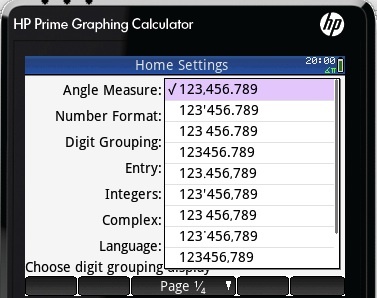 Calculator aficionados need to pay attention when getting second hand units, because there is nothing in the calculator body that help discerning one from the other. Nothing at all. The onto way to know it is to press the help key, and then about… There it says the revision number and the firmware.
Calculator aficionados need to pay attention when getting second hand units, because there is nothing in the calculator body that help discerning one from the other. Nothing at all. The onto way to know it is to press the help key, and then about… There it says the revision number and the firmware.
Not all firmwares are valid for all versions, so pay attention when forcing the update of your unit (there are cases where the updating function in the connectivity kit tells the user that there are not updates available, and sometimes the user forces the upgrade with other tools like the update.exe windows program.
By the way: to make the decision easier and safer, we have created a pack with an hp Prime and a Streamsmart 410, guaranteed to work together.
We have also posted a number of Fourier probes here. Please remember that you need a cable for all of them, although you only need at most 4 cables, if you want to measure 4 magnitudes in parallel.
RPN Spreadsheet behaviour
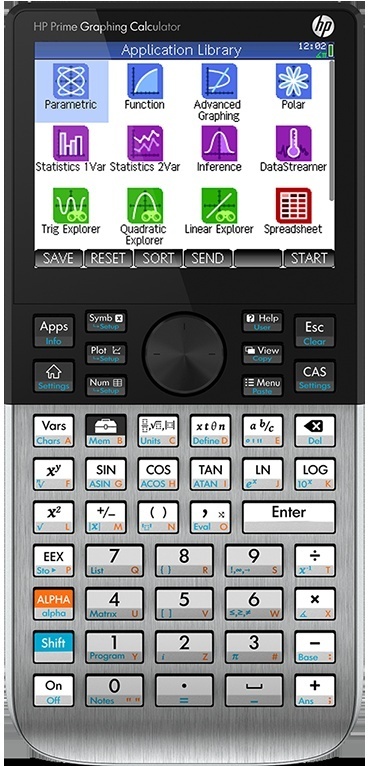 The other day my youngest son was writing a multiplication table from 1 to 12. He’s just finished to learn the tables and he was told to write the table.
The other day my youngest son was writing a multiplication table from 1 to 12. He’s just finished to learn the tables and he was told to write the table.
I thought I could do it with the spreadsheet feature of the prime, so that he could check the results (and hopefully get interested in the calculator features)
I imagined that I could find variables like Row and Col, so that I could write a cell like Row * Col and then copy it to a square of 12 * 12 (the table he’s been asked to write is 12*12)
Well, to begin with, the Spreadsheet app takes into account your choice of entry mode. That is, if you have RPN, you can’t write 5*3 and press enter, you need to write in RPN: 5 3 *.
Moreover, I was able to enter any arithmetic function in the spreadsheet in RPN, but I could not make the variables work in RPN. So I switched to algebraic entry. I could have moved to CAS instead - it is always non-RPN.
Once set like that, I only had to write Row*Col, and compy that expression to all the cells of the 12*12 square. Then my son could check if he had done it properly.
I need to investigate more this RPN behavior in the Prime Spreadsheet.
More Fourier Probes for the HP Prime
Due to the enquiries received, I am going to print the full list of probes, all with their operating ranges and specs. While you’re not likely to find Higgs’ boson with these instruments, you can create a significant lab for your school - and these instruments are a fraction of the price of what HP (after that Agilent and now Keysight Technologies) would cost.
Here is the list:
| Part Number | Description | Subject | Range / Spec |
| Physics / Chemistry Biology / Environment | |||
| DT138 | Acceleration | P | ±5g |
| AC020A | Ammonium Electrode + ISE Adaptor (AC021) | C B E | 0.1-18,000 ppm |
| AC020 | Ammonium Electrode | C B E | 0.1-18,000 ppm |
| AC021 | Ion Selective, Electrode Adapter, (ISE Adapter) | ||
| AC012A | Anemometer | E | 4-280 km/h, 0°-360° |
| DT098 | Blood Pressure/Heart Rate | B | BP: 0-375 mmHg; HR: 36-200 bpm |
| DT040A | Carbon Dioxide Gas, CO2 | C B E | 350-5,000 ppm |
| AC019A | Calcium Electrode + ISE Adaptor (AC021) | C B E | 0.02-40,000 ppm |
| AC019 | Calcium Electrode | C B E | 0.02-40,000 ppm |
| AC021 | Ion Selective, Electrode Adapter, (ISE Adapter) | ||
| AC018A | Chloride Electrode + ISE Adaptor (AC021) | C B E | 1.8-35,500 ppm |
| AC018 | Chloride Electrode | C B E | 1.8-35,500 ppm |
| AC021 | Ion Selective, Electrode Adapter, (ISE Adapter) | ||
| DT185A | Colorimeter | C B E | 3 colors |
| DT035A | Conductivity Electrode + Sensor Adapter | C B | 0-20mS |
| DT035 | Conductivity Sensor Adapter | C B | |
| DT050 | Conductivity Electrode | C B | 0-20mS |
| DT111 | Control Switch | P | N/O |
| DT110 | Control Switch | P | N/C |
| DT005 | Current | P | ±2.5A |
| DT006 | Current | P | ±250mA |
| DT020-1 | Distance (for NOVA5000, MultiLogPRO and NOVA LINK) | P B | 0.2-10m |
| DT187A | Distance (for EcoLogXL) | P B | 0.2-6m |
| DT100A | Drop Counter | C B | 0-4,095 drops |
| DT189A | EKG | B | 0-5V |
| DT261A | Electrostatic Charge | P | ±0.25µC, ±0.025µC |
| DT254 | Flow Rate | P C B E | 0-4mls |
| DT272 | Force | P C | ±10N, ±50N |
| DT116 | Geiger Muller | P C E | 0-4,096 Bq |
| DT155A | Heart Rate (Pulse) | B | 0-200 bpm |
| DT298A | Heart Rate (Exercise) | B | 0-200 bpm |
| DT014 | Humidity (5% Accuracy) | B E | 0-100% |
| DT009-1 | Light | P C E | 0-300 lux |
| DT009-4 | Light Multi-Range | P C B E | 0-600, 0-6,000, 0-150,000 lux |
| DT156 | Magnetic Field | P E | ±10mT, 0-0.2mT |
| DT036 | Dual Axis Magnetic | P E | ±0.2mT, ±40mT, ±100mT |
| DT008 | Microphone | P | 35-10,000 Hz |
| AC017A | Nitrate Electrode + ISE Adapter (AC021) | C B E | 0.1-14,000 ppm |
| AC017 | Nitrate Electrode | C B E | 0.1-14,000 ppm |
| DT222A | Oxygen Sensor Adapter + Oxygen Electrode | C B E | Water: DO2: 0-12.5mg/L Air: O2: 0-25% |
| DT222 | Oxygen Sensor Adapter | C B E | N/A |
| DT118 | Oxygen Electrode | C B E | Water: DO2: 0-12.5mg/L Air: O2: 0-25% |
| DT016A | pH Electrode + pH Sensor Adapter | C B E | 0-14 pH |
| DT018 | pH Electrode | C B E | 0-14 pH |
| DT017 | pH Sensor Adapter | C B E | N/A |
| DT137 | Photo Gate | P | 0-5V |
| AC008A | Potassium Electrode + ISE adapter (AC021) | C B E | 90.04-39,000 ppm |
| AC008 | Potassium Electrode | C B E | 90.04-39,000 ppm |
| DT015 | Pressure | P C B E | 150-1,150 mbar |
| DT015-1 | Pressure | P C B E | 0-700 KPa |
| AC013A | Rain Collector | E | 0-819 mm |
| DT148A | Rotary Motion | P | ±128° |
| DT122A | Smart Pulley | P | 0-99 m/s |
| DT171A | Soil Moisture | B E | 0-200 cbar |
| DT320 | Sound Level | P E | 25-110 dB |
| DT037A | Spirometer | B | ±315 Liter/min |
| DT029 | Temperature (for NOVA5000, MultiLogPRO and NOVA LINK) | P C B E | -25 to 110°C |
| DT027 | Temperature PT-100 | P B E | -200 to 400°C |
| DT025 | Temperature | P C B E | 0 to 1,200°C |
| DT241 | Temperature (for EcoLogXL) | P C B E | -25 to 110°C |
| DT095A | Turbidity | C B E | 0-200 NTU |
| DT063 | UVA/B | B E | UVA: 320-400 nm; UVB: 280-320 nm |
| DT002 | Voltage | P | ±2.5V |
| DT003 | Voltage | P | 0-5V |
| DT019 | Voltage MultiRange | P | ±1V, ±10V, ±25V |
| DT001 | Voltage | P | ±25V |
Interested in any in particular? Email us to sales@thecalculatorstore.com
Fourier Probes
 We’re filling in data in the website about the Fourier probes for the HP SmartStream 410. Both are part of HP’s plan to recover the educational market that was lost to Texas due to several factors - one of them, the direction of HP of that time towards the higher end, the engineers and the high level financial users. But they forgot that the children end up being professionals - and that market is nearly lost too.
We’re filling in data in the website about the Fourier probes for the HP SmartStream 410. Both are part of HP’s plan to recover the educational market that was lost to Texas due to several factors - one of them, the direction of HP of that time towards the higher end, the engineers and the high level financial users. But they forgot that the children end up being professionals - and that market is nearly lost too.
Well, coming back to the probes. These are interesting equipment if you want to set up a lab for the school kids. Lets see some of the probes that we’re getting in the first batches:
- Current, 250 mA
- Current, 2,5 A
- Voltage, multi range (from 2,5v to 25v)
- SPL sensor
- Microphone
- Termocouple for temperature measures
- Acceleration
- PH meter
- humidity meter
- Force meter
- Luminosity
- Distance
- Electrostatic charge
- Magnetic field
All of them are automatically detected by the system Prime-Smartstream, and can stream up to 5700 samples per second (this is enough to monitor up to 2,85 kHz waveforms). A special cable is required to link them with the machine, but they come with cables for the probe itself (the part that gets in contact with the thing to be measured)
Once we have the whole system set, we will try to run a comparison with a system a little bit older: an HP41CL, linked through HP Il with a HP 3468A multimeter. That’ll be fun: the superior speed of the new system, against the professional quality of HP of the ‘80s.
HP Prime's wireless kit
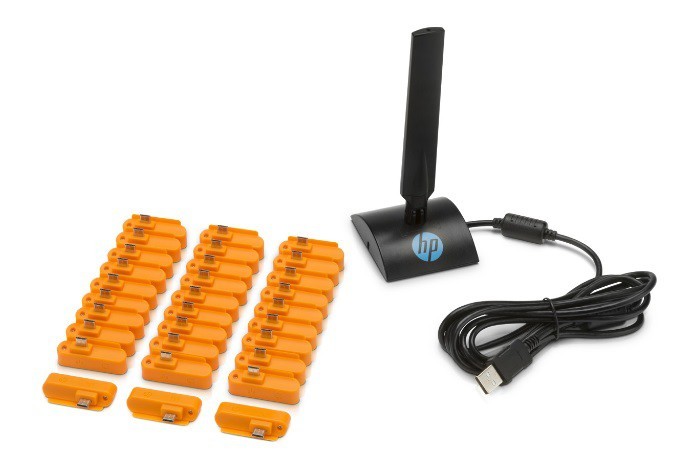 Finally we have the wireless kit for the HP Prime. This is a device intended only for a professor to run his class - it really does not have any other application that I can think of now.
Finally we have the wireless kit for the HP Prime. This is a device intended only for a professor to run his class - it really does not have any other application that I can think of now.
But, oh my, is it useful for its intended use!
Let’s picture some of the things you can do with it:
- From a single computer, you can see the screens of all your pupils on your screen. Don’t allow any of them to wander around or switch the calculator off.
- You can download exercises and apps to their computers - very much like you can do now with your HP Prime and the supplied emulator, but not having to be linked by USB.
- You can track how they are performing with the exercises that you have sent to them.
- You can send polls and exams to their Primes, to be answered and returned back to you.
- You can set the exam mode of their calculators: what they can and the can’t do in this particular exam with their Primes (if you look to the settings page, you get the idea of what you can allow and what you can forbid - and the grain is quite thin!
The wireless kit is composed of a PC antenna, that is connected through USB to the professor computer, and 30 dongles to be connected to each students’ Prime. A special software for the computer is required (connectivity kit or HP Classroom Manager) This is the intended way of working: the wireless kits are not intended to communicate between Primes (no, they cannot share the results of the tests you’ve just sent to them!). The price of the kit is 699, but there are discounts available for more classes than one (i.e., a full school or just a year of three classes)
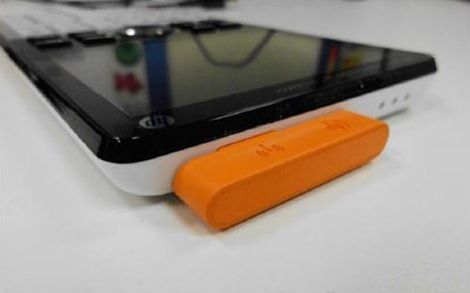
HP's own website for the HP Prime
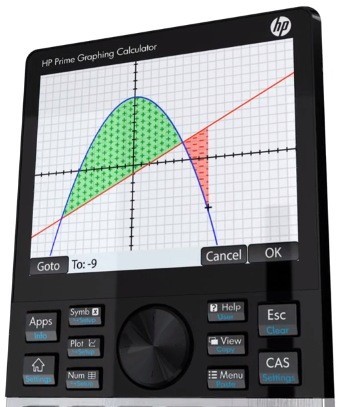 If you have a HP Prime, you need to put this website among your favorites:
If you have a HP Prime, you need to put this website among your favorites:
http://www8.hp.com/us/en/campaigns/prime-graphing-calculator/overview.html?jumpid=va_a5cqf1p9xi
This is HP’s own Prime website. It is still in creation, and they are putting together lessons and material for education with the HP Prime.
At this point in time, when you see the lessons tab in the web page, you can only see the statistics lessons. There will be other chapters:
Algebra 1
Geometry
Trigonometry
Pre-calculus
Calculus
and more. I have sampled some of the pdf documents, and they are extremely short. They are not intended to learn the subject itself - it is only intended to teach you how to do it with the HP Prime. Quite elemental - but this is what you need when you’re a kind that is trying to learn at his level, not at university level.
You have also access to the latest prime manuals, several other documents to show the possibilities of the Prime, and several videos doing the same.
Yes, it is only the start, but it will grow over time.



